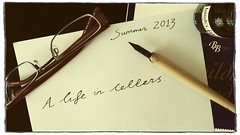The Letters of Vincent Van Gogh
I am only half way through this collection (it is 500 pages long, so I will probably do a review of the second half next week). Although I have been slow with my reading this week it is not because this is a difficult read, in fact, quite the opposite. This is a collection to be savoured as, among other talents, Van Gogh was a fantastic letter writer.
The collection almost feels like a diary rather than letters as they are very personal and we only have one side of the correspondence. The book is filled, in the main, with Vincent's letters to his younger brother Theo, who must have been quite a hoarder as it seems that he kept every letter he received. There is at least one letter from Theo in the collection, but we only have that as Vincent sent the letter back to his brother with numbers in the margins as a time expedient way of responding to his brother's criticisms (Vincent had just had a blazing row with his mother and father and been thrown out of the house).
The letters start three years after Vincent began working at the art dealers Goupil & Cie. He begins his career in the Hague and then is transferred to the London branch in June 1873. Vincent eventually loses his job with the art dealers and spends some time working as a teacher before returning to the Netherlands and working in a bookshop. This period, when he loses his job in London and returns to the Netherlands to work in a bookshop, is Vincent's religious period and his letters are full of his plans to follow his father into his noble position as a clergyman. During a period working as an evangelist in a mining village in Belgium, Vincent decides to become an artist. The letters have not been as full of art as I would have expected (he mentions his predilection for Ingres paper (a type of drawing paper), live models for his drawings and the problems of finding a suitable studio), but I think that the focus on art and painting will increase in the second half of the collection, now that he has abandoned his religious leanings and his infatuation with his cousin Kee Vos.
Almost thirty pages of the book are taken up by Vincent's love problems. He falls violently in love with his widowed cousin Kee, who tells him that she could never be with him. Despite this setback, Vincent continues to ask her father for her hand in marriage and the letters of this period detail his perseverance in the face of adversity and his family's increasing discomfort in the face of his obsession.
These letters seem to contain all sorts of thoughts and feelings that many others might choose to write in a diary rather than in a letter. Vincent seemed to recognise the dramatic and revelatory nature of his letters, as in one letter he writes,
"Write to me soon and try to separate the wheat from the chaff in my letters. If there is some good in them, some truth, tant mieux,* but there is, of course, much in them that is more or less wrong or exaggerated perhaps, without my always being aware of it."* So much the better.
It is this, I suppose, that makes the letters so readable.


No comments:
Post a Comment